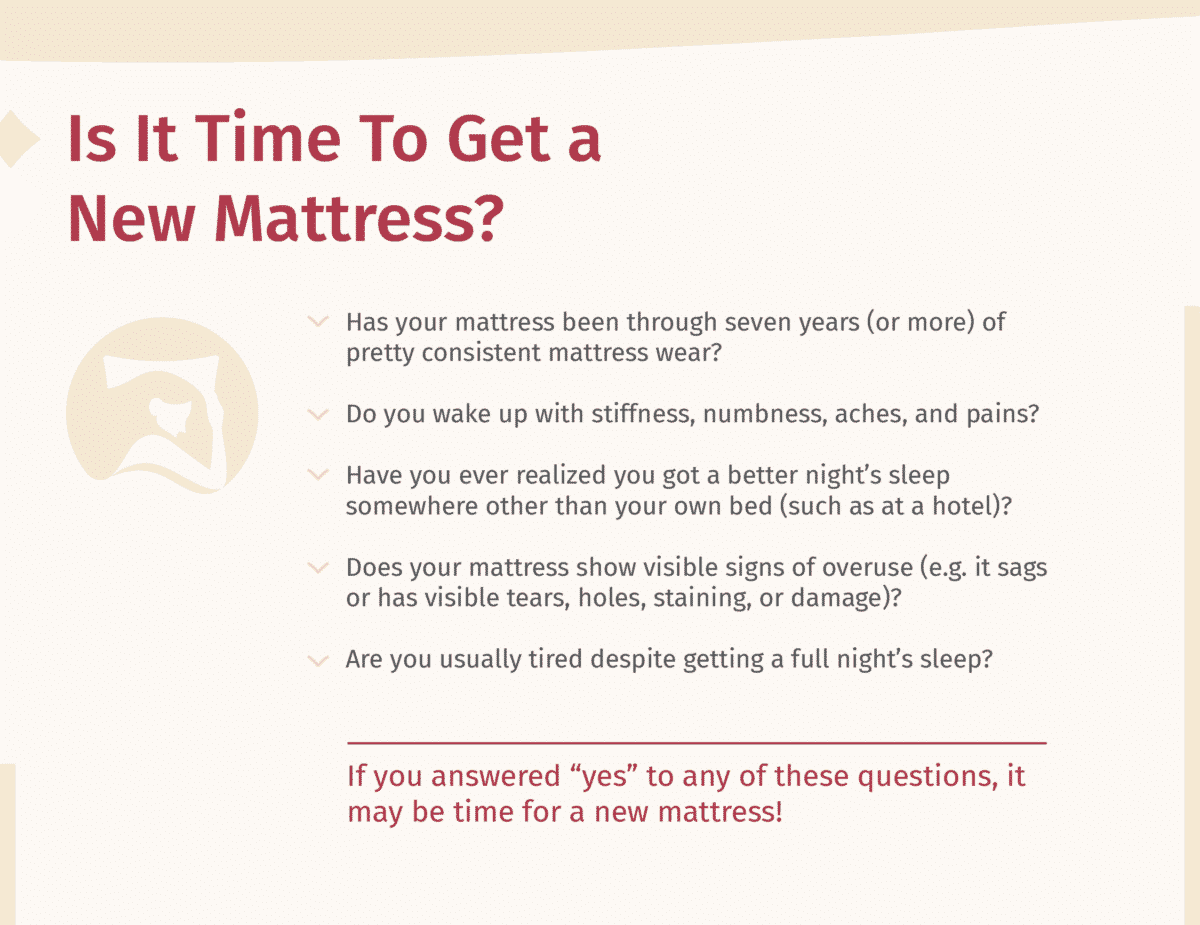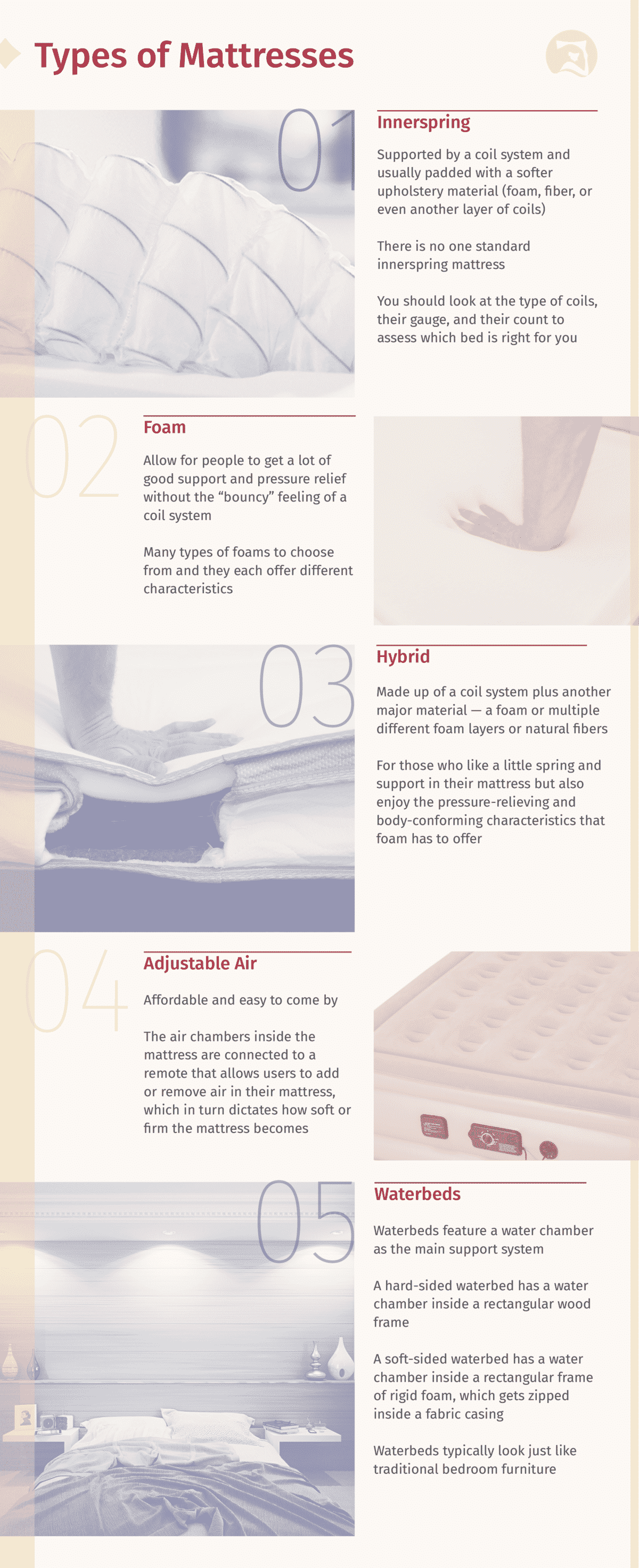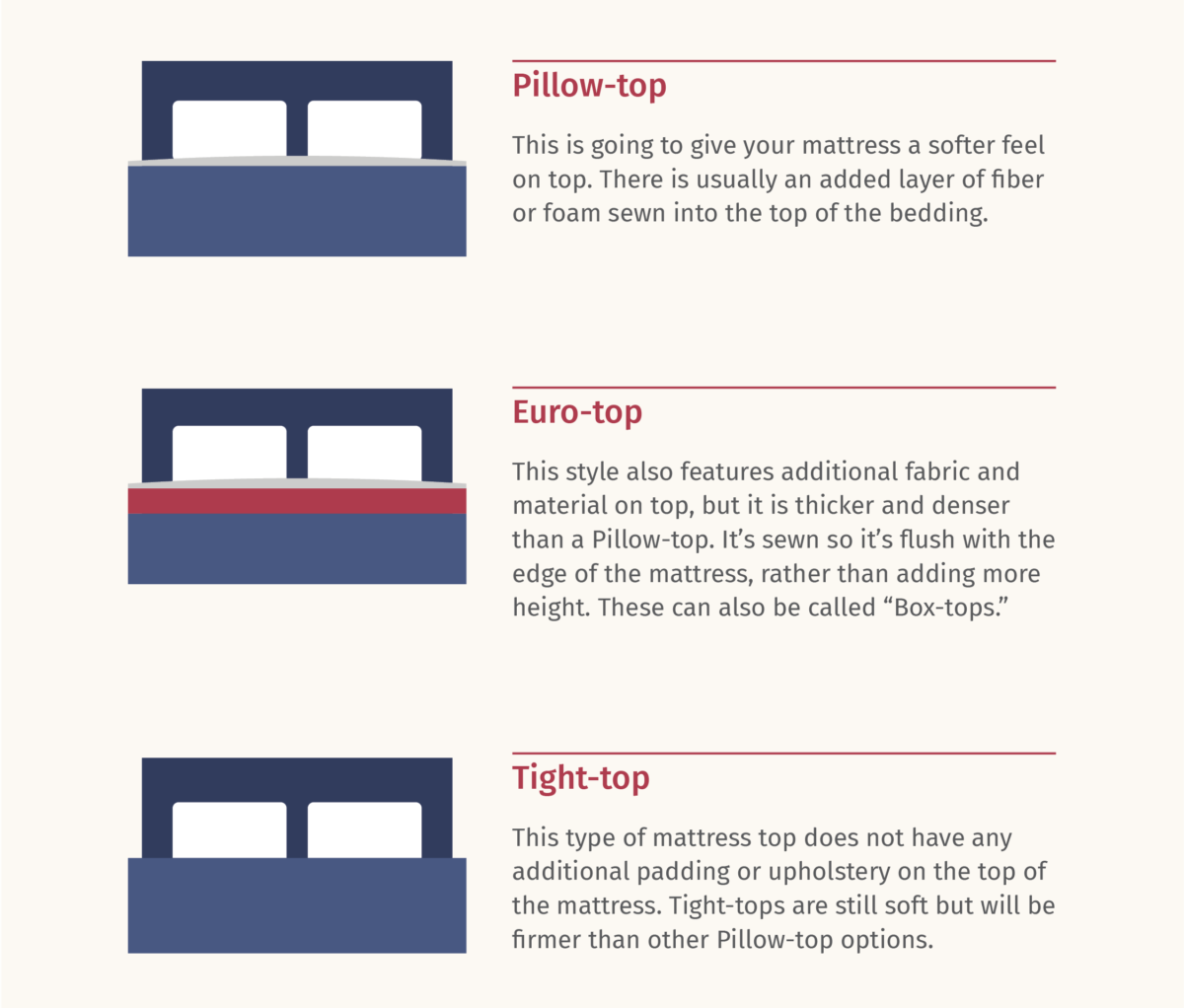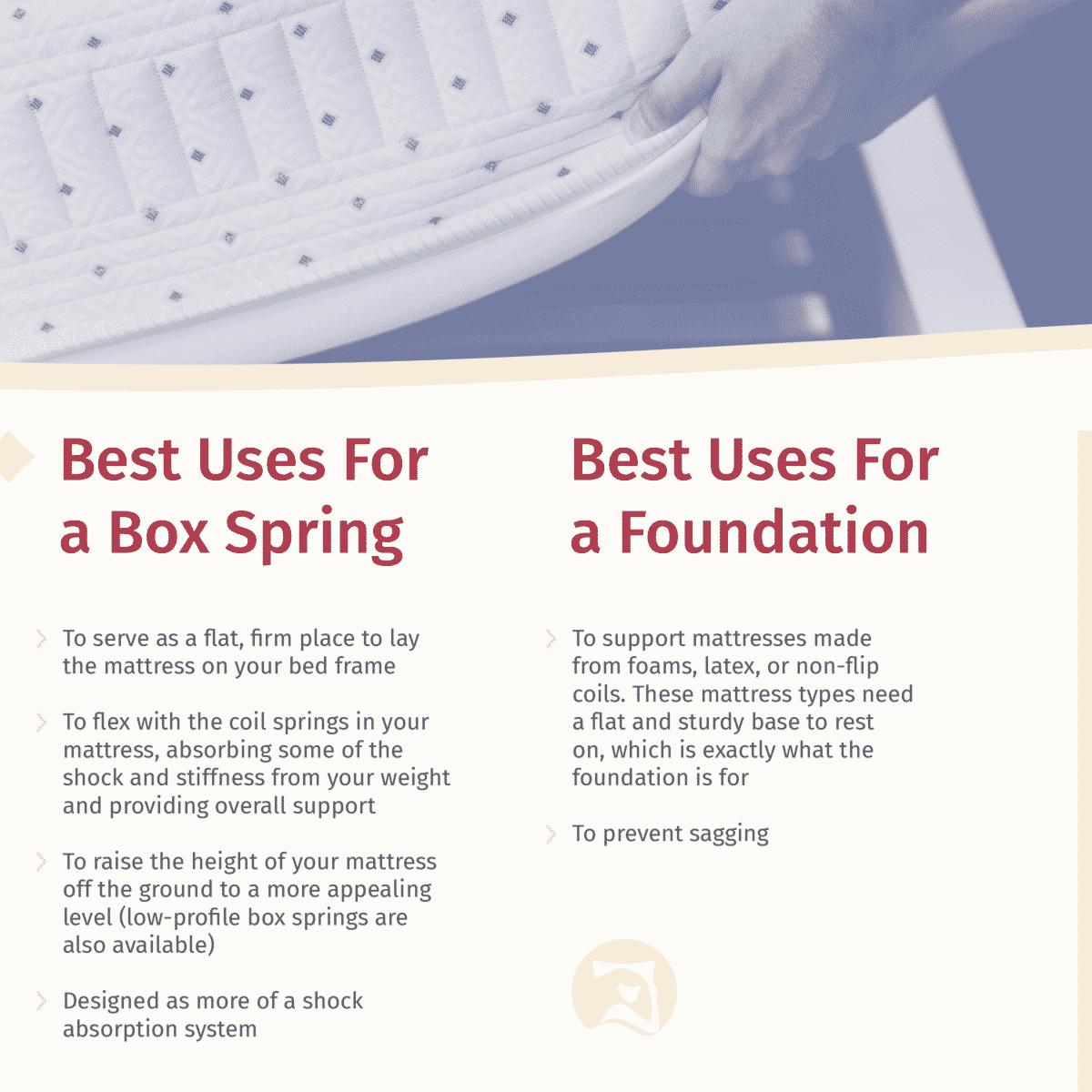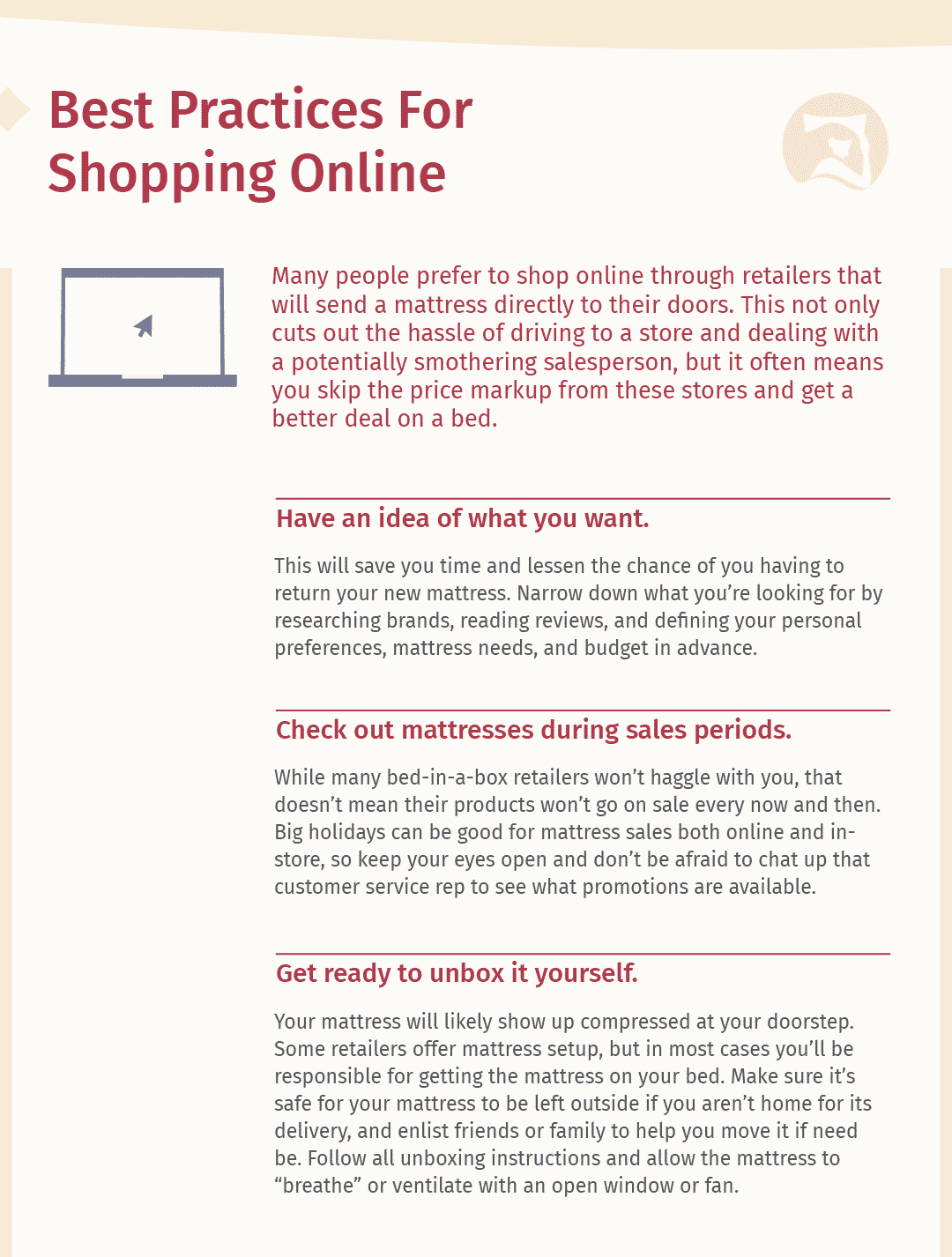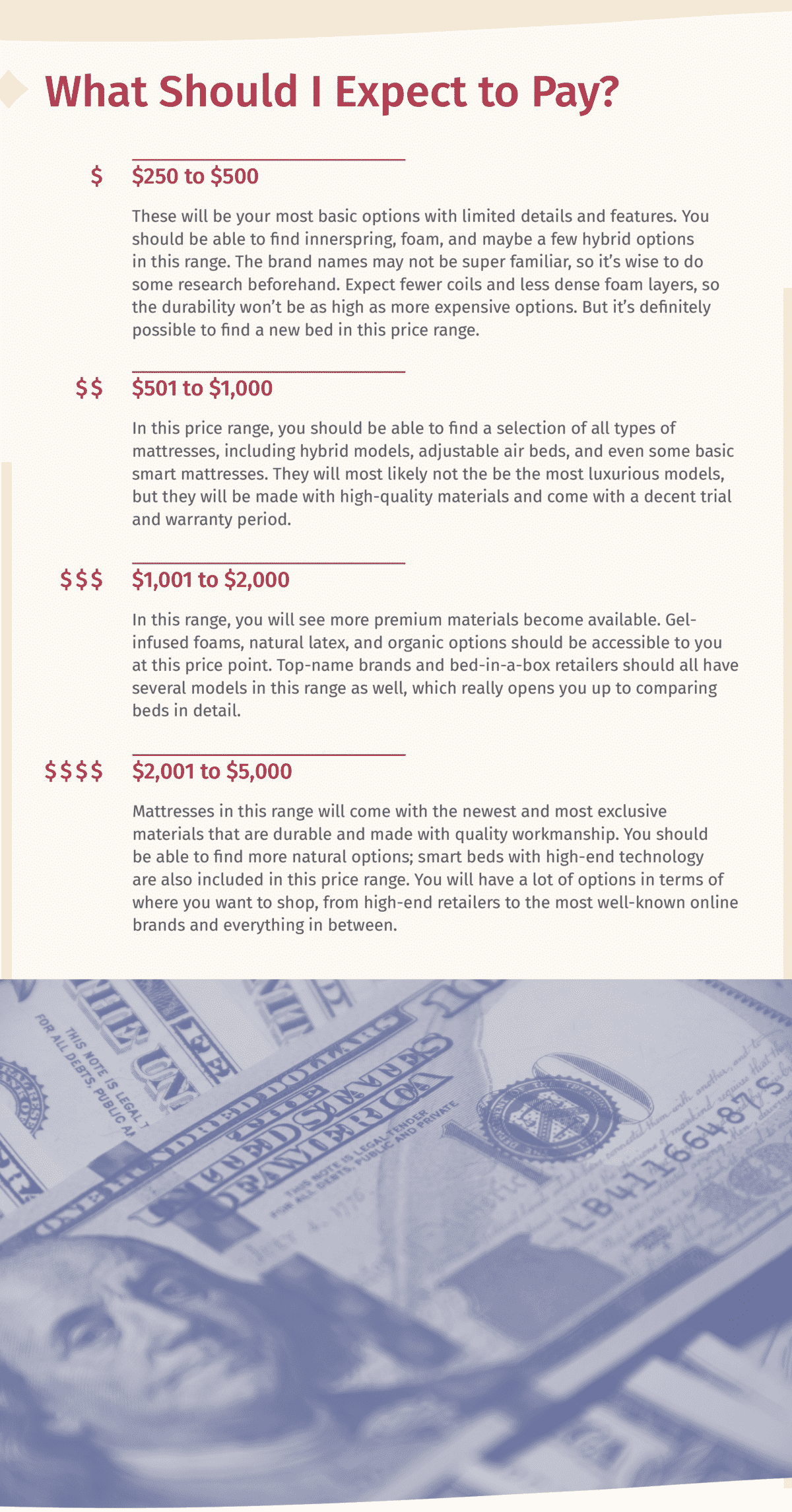Investing in a new mattress can seem like an overwhelming task. The mattress industry has grown significantly, and with that comes more choices than ever before. Not only are there many different types of mattresses to serve different body types and sleep positions, but there is also a range of innovative features and options to consider.
It’s no surprise if you’re left wondering how to choose a mattress that will be best for you, and that’s where we come in to help. First, take a deep breath — because we have it covered. This is the most comprehensive mattress guide to buying out there, and it will help direct mattress shoppers to the right bed and a great night’s sleep.
Read on for our full mattress buying guide, and then check out our mattress reviews when you’re ready to start shopping.
Jump To:
When to Buy a New Mattress | What to Look for | Mattress Sizes | Mattresses Types | Mattress Tops | Sleep Position| Specific Sleep Needs | Mattress Support | In-Store Shopping | Online Shopping | Buying a Used Mattress | Mattress Prices | Trial Periods & Warranties | Mattress Delivery | Mattress Protectors | Pillows | Keeping a Mattress Clean | Bottom Line
When to Buy a New Mattress
There are no hard or fast rules when it comes to swapping out a mattress. Durable mattresses made with high-quality materials will outlast cheaper ones, and the level of wear and tear a mattress undergoes will also be a factor in how long it lasts.
That being said, here are some general guidelines from the Better Sleep Council to figure out if it’s time to consider buying a new mattress:
- It’s been seven years (or more) of pretty consistent mattress wear.
- Waking up with stiffness, numbness, aches, and pains.
- Getting better sleep somewhere else (such as a hotel).
- Visible signs of overuse (e.g. it sags or has visible tears, holes, staining, or damage).
- Being constantly tired despite getting a full night’s sleep?
- The comfort and support isn’t what it used to be.
What to Look for in a New Mattress
Once you’ve decided to replace your mattress, what should one expect from a new mattress and what is the best mattress? Here’s a list of things to think about before handing over the credit card for a new purchase
Comfort and Cooling
It is a pain to wake up in pain! No one should have to wake up on a mattress feeling stiff or sore. Also, no one should wake up drenched in sweat or kicking all the covers off overnight because your mattress isn’t breathing well. Of course, there is a little bit of an adjustment period involved in testing out a new bed. Take advantage of those trial periods and try something else if it doesn’t feel right.
Support and Neutral Spine Alignment
It feels best when the head, neck, and spine are in neutral alignment, no matter the sleeping position. Without this natural alignment, sleepers may feel stiffness or aches when they wake up.
Lifespan, Longevity, and Durability
For most people, a mattress is a big investment. That means it’s important to think about how long one wants a new bed to last. Mattresses made with high-quality materials and good construction will easily outlast cheaper options, which means it won’t be necessary to buy a new mattress as frequently.
Motion Transfer
For those who sleep with a partner, motion transfer is extremely important. A mattress that handles motion transfer well will ensure that sleeping partners do not disturb one another when they move around at night. Those who want a mattress with little motion transfer should consider something with memory foam. This material is known for cutting down on motion transfer.
Edge Support
Different mattresses will provide varying degrees of edge support. A mattress with great edge support allows sleepers to rest close to the edge and maximize the surface area. Poor edge support will leave sleepers feeling like they are going to roll off the bed when they get close to the edge.
Budget-Friendliness
No one wants to feel like they broke the bank for a new bed. There are plenty of options out there, so it’s possible to find something that meets one’s needs without going into debt, whether you’re looking for a cheap mattress or a luxury option.
Safety
Before purchasing a new mattress, it’s a good idea to look at the company’s reputation and see how transparent they are about where their materials come from. (This is especially true for materials such as fire retardants. It’s also particularly important to do your research before buying a crib mattress for a new baby.) Also, whenever purchasing any type of mattress, make sure the mattress still has its tag on.
Mattress Sizes
In some cases, it’s not always clear which mattress size is right for a room. Here are a few factors to consider when deciding on the right mattress:
- Consider how much sleeping surface area will be available (and partners if this applies).
- Consider whether the mattress would leave enough extra room in the bedroom for moving around, hanging out, and relaxing.
- Consider whether the size is worth the price. Don’t spend more on a bed than you need to. Rarely is a King necessary for a single person, unless just wanting to fill the space of a room.
Still not sure which mattress size is right? Below we’ve put together details on each mattress size to further inform that next big purchase.
Twin
The dimensions of a Twin bed are 39” x 74” (sometimes 75”). Outside of a toddler bed or crib, a twin is the smallest mattress size available. It’s great for children, teens, or adults who are smaller in stature or who are working with limited space. It’s not a recommended size for those sleeping with a partner.
RELATED: Best Twin Size Mattress
Twin XL
A Twin XL is 39” x 80”. It’s six inches longer than a Twin, but it has the same width. This makes it great for taller children or teens or for adults who are working with a narrow bedroom. Twin XL sheets are not difficult to come by, as many college dorm beds are Twin XL size.
RELATED: Best Twin XL Mattress
Full/Double
A Full or Double size mattress is 54” x 74” (sometimes 75”). It has the same length as a Twin mattress, but it is 15” wider. A Full can be great for someone who sleeps alone and wants a little more room or for couples who are smaller in stature or only have room for a Full/Double bed.
RELATED: Best Full Size Bed
Queen
A Queen mattress comes in at 60″ x 80″. This is a solid option for a single person who prefers extra space and has the room for it in their bedroom. It’s also big enough for most couples to sleep together comfortably.
RELATED: Best Queen Mattress
Standard (Eastern) King and Split King
The dimensions for a standard King size mattress are 76″ x 80″. That makes it the same length as a Queen but 16″ wider. A King is the best fit for couples or people who share a bed with their children (provided they can afford — and prefer — the extra space). It is probably not necessary for a single person unless they are looking to fill up a very large master bedroom.
A Split King has the same dimensions as a standard King, but it is either split halfway down or straight down the middle — making it the same as two Twin XL mattresses pushed together.
RELATED: Best King-Size Mattress
California (Western) King
A California King mattress is 72” x 84”. It’s about four inches longer than a Standard King but four inches narrower in width. The CA King is all about adding extra length to the bed while sacrificing some surface area. Taller individuals may prefer this type of mattress.
RELATED: Best California King Mattress
Here’s the bottom line on mattress sizes: When it comes to sizing, there’s no one right answer. Assess your sleep situation, personal preferences, and budget, and then shop around for the best option.
Trying to decide between two sizes? We’ve got a list of mattress size comparisons to make it an easy decision:
- Twin vs. Twin XL Beds
- Full vs. Twin Beds
- Full Bed vs. Twin XL Beds
- Twin vs. Queen Beds
- Twin XL vs. Queen Beds
- Full vs. Queen Beds
- King vs. Twin Beds
- King vs. Twin XL Beds
- King vs. California King
- California King vs. Twin XL Beds
- California King vs. Twin Beds
Types of Mattresses
One of the first questions you’ll face when deciding on a new mattress is which type of mattress you want to buy. There are more mattress types available than ever before, and they each come with their own pros, cons, and distinct features. Here’s an overview of the different types of mattresses you’re likely to encounter in your quest for a new sleeping surface.
Innerspring Mattresses
When people hear the word “mattress,” they often think of a traditional innerspring mattress. More than 60 percent of today’s mattress sales are innerspring mattresses, according to Consumer Reports. This popular mattress type is supported by a coil system and usually padded with a softer upholstery material (foam, fiber, or even another layer of coils).

There is no one standard innerspring mattress. Look at the type of coils, their gauge, and their count to assess which bed is right.
Types of Coils
- Bonnell coils. These are considered the oldest and most commonly used type of coil. They’re an hourglass shape, and their ends are wrapped around a circular top and bottom for comfort. The more tightly coiled center is less responsive so it
enhances stability. The coils are laced together, and this continuous system is known for its balanced body support. - Offset coils. These are more likely to be found in higher-end mattresses. Although they are not shaped much differently than the Bonnell coil, they have squared ends that offer a more durable feel and are less noisy.
- Marshall/Pocketed coils. These barrel-shaped coils are wrapped in a fabric casing. (Sometimes the coils are wrapped together; sometimes they’re individually wrapped.) They are great for reduced motion transfer and do a good job of letting the body conform to the mattress.
- Continuous Wire System. Think of this system as a large network of coils that weave throughout the mattress. They offer good support in the center third of the mattress so those who want added back support may want to look for these.
The Range of Gauges
The number attributed to a coil gauge refers to its thickness. For mattresses, 12 to 15 is a typical range. The higher the number, the thinner the coil. Thinner coils will give the mattress a softer overall feel. The lower the gauge, the thicker the coil and the firmer or more supportive the mattress system. The relative softness or firmness of a mattress is also influenced by the coils system and the type of coils present in the mattress.
Coil Count
Typically, the higher the coil count, the better the quality of the mattress. Coil counts can range from about 250 per mattress to 1,000-plus depending on the size. That being said, even if a mattress has a lot of coils, they may be thinner (have a higher gauge) than another mattress with fewer but thicker coils — so it’s still important to think about gauge and type as well as count.
Flipping vs Rotating Coil Systems
Some innerspring or hybrid mattresses are two-sided and flip-able, while others cannot be flipped and should just be rotated. The coil systems in each of these mattresses are supported differently. In a two-sided, flip-able mattress, comfort layers are placed on the top and bottom of the coil system. In a one-sided, no-flip mattress, comfort layers are only built on top of the base coil system.
These different types of mattresses may need to be supported in different ways, so always check with the manufacturer to see if a box spring or foundation is required for a particular innerspring bed. (We’ll talk more about box springs and foundations later on in this guide.)
Foam Mattresses
Foam mattresses have become increasingly popular. They allow for people to get a lot of good support and pressure relief without the “bouncy” feeling of a coil system.
There are many types of foams to choose from, and they each offer different characteristics. Below are some of the most common options for foam mattresses.
Memory Foam
 Memory foam is made up of a material called viscoelastic polyurethane foam. Mattress retailers say that memory foam mattresses provide health benefits. The conforming ability of memory foam, for example, may allow for better spinal alignment, which can be great for those with back pain issues.
Memory foam is made up of a material called viscoelastic polyurethane foam. Mattress retailers say that memory foam mattresses provide health benefits. The conforming ability of memory foam, for example, may allow for better spinal alignment, which can be great for those with back pain issues.
Pay close attention to the memory foam density. Foam density is measured in pounds per cubic foot. Mattresses are often 2 to 5 pounds per cubic foot. Memory foam mattress density levels typically fall into one of the following three categories:
- Low-Density: 3.5 lb/cubic ft and under
- Medium Density: above 3.5 lb and below 5lb/cubic ft
- High-Density: 5 lb/cubic ft or more
In many mattresses, the base layer is often the thickest foam layer (in terms of height). The higher the density of the base layer, the more support the mattress will provide overall.
Higher density means there is more foam per cubic foot within the mattress layer. This translates to higher durability and higher quality. (Yes, the mattress will most likely be more expensive.) More expensive mattresses will tend to have more memory foam than other types of foam as well.
Keep in mind that density does not equal firmness when it comes to foam. However, higher density typically means more durability and more support.
Latex Foam
Latex has some of the characteristics of memory foam mattresses without some of the less popular attributes. Latex is comfortable and supportive but generally breathes well (meaning it won’t get hot) and recovers faster than pure memory foam. This means you’ll get less of that “sinking in” feeling compared to memory foam. It’s a durable foam as well.
There are two processes that turn latex (natural or synthetic) into foam: The Dunlop method or the Talalay method. Both methods involve washing the latex foam to remove impurities and additives. There are a few difference between the two processes, which you can read more about in our guide to natural latex. The bottom line is that Dunlop feels more stable and supportive, while Talalay can be made with different grades of softness.
Also, if you’re wondering about latex mattress allergies, read our informative article. It covers exactly how these latex allergies work.
RELATED: Memory Foam Vs. Latex
Gel
Adding gel to a foam mattress is common practice these days. The idea is that the gel will help dissipate heat and keep the mattress cooler and more breathable. Mattress retailers use different types of technology to make gel memory foam. There is limited scientific data on whether or not infusing gel into a foam will actually help it stay cooler, but that doesn’t mean it’s not worth asking a brand what technology they use and how they make it work.
Proprietary Blends and Mixes
You may notice that mattress retailers have special foam options with names that are proprietary to their brand. This is because foam manufacturers are able to make special blends or mixes of foam for specific retailers.
These “exclusive” foams will be layered into mattresses and will have different characteristics and densities. It’s wise to ask a salesperson or customer service representative more details about how the foam feels and how it sleeps (especially how it breathes!).
Hybrid
A hybrid mattress is made up of a coil system plus another major material — a foam or multiple different foam layers or natural fibers. People tend to gravitate toward hybrid mattresses when they want the qualities that both a coil system and foam can provide, namely a good balance of comfort and support. Often this means they like a little spring and support in their mattress but also enjoy the pressure-relieving and body-conforming characteristics that foam has to offer.
Natural Fibers and Natural Latex
 Mattresses can be made with more natural and sustainable materials. Natural mattress makers often use materials such as sheep’s wool, organic cotton, and natural latex in their beds instead of steel coils or synthetic foams. More often than not, these beds will cost a little more because these materials tend to be more expensive.
Mattresses can be made with more natural and sustainable materials. Natural mattress makers often use materials such as sheep’s wool, organic cotton, and natural latex in their beds instead of steel coils or synthetic foams. More often than not, these beds will cost a little more because these materials tend to be more expensive.
Because latex is naturally occurring, it’s easier to find natural, plant-based versions in a mattress. Fans of natural latex bedding products note that natural latex is resistant to mildew, mold, dust mites, and bacteria. If having natural latex in your mattress is important to you, you’ll need to do a little extra research to see if it’s 100% natural or a blend of natural and synthetic latex.
Adjustable Air
Chances are, you’ve slept on an inflatable air mattress or bed before. These compact beds are affordable and easy to come by. However, there are also mattresses that have built-in air chambers, and these are a bit different. While the concept is the same as an air mattress, their construction is more complex and durable.
Sleep Number beds are a good example of adjustable air beds. These beds don’t look like an inflatable mattress; they look like a standard bed. The air chambers inside the mattress are connected to a remote that allows users to add or remove air in the mattress, which in turn dictates how soft or firm the mattress becomes. The mattress often includes other upholstery or material, such as foam or natural fibers, for support and comfort.
Waterbeds
Instead of materials such as coils or foam, waterbeds feature a water chamber as the main support system. Typically, they are available in two styles: hard-sided or soft-sided beds. The Better Sleep Council says a hard-sided waterbed has a water chamber inside a rectangular wood frame. A soft-sided waterbed has a water chamber inside a rectangular frame of rigid foam, which gets zipped inside a fabric casing. You don’t sleep directly on the chamber; it has a layer of foam and/or fibers that usually lies on top of a platform. Waterbeds typically look just like traditional bedroom furniture.
In the mid-1980s, waterbeds made up 20% of the bed market. Today, they’re less popular but still in existence. There are retailers and showrooms across the country that happily offer these throwback mattresses.
Smart Mattresses
S mart beds and smart mattresses are an up-and-coming group of mattresses. They look and (for the most part) feel exactly like a standard foam/innerspring/air/hybrid mattress, but they come with enhanced functionality designed to help optimize sleep.
mart beds and smart mattresses are an up-and-coming group of mattresses. They look and (for the most part) feel exactly like a standard foam/innerspring/air/hybrid mattress, but they come with enhanced functionality designed to help optimize sleep.
Smart mattresses provide a range of services and employ different technologies. Some are able to monitor vitals through sensors in the bed, while others sync with apps on a phone to help track the quality of sleep each night. The basic idea is that with the help of a smart mattress, one can identify potential sleep issues and make changes to sleep habits that will help one sleep longer and deeper and wake up more rested. At least that’s the idea!
Mattress Tops
We’re wrapping up our section on different mattress types on top — on the mattress top, to be exact. In addition to choosing the right combination of materials in your mattress, you may also have to pick what kind of top you like. Terms such as “Pillow-top,” “Euro-top,” “Box-top” or “Tight-top” are very common. So what do those mean? Here’s a breakdown:
- Pillow-top. This is going to give the mattress a softer feel on top. There is usually an added layer of fiber or foam sewn into the top of the bedding.
- Euro-top. This style also features additional fabric and material on top, but it is thicker and denser than a Pillow-top. It’s sewn so it’s flush with the edge of the mattress, rather than adding more height. These can also be called “Box-tops.”
- Tight-top. This type of mattress top does not have any additional padding or upholstery on the top of the mattress. Tight-tops are still soft but will be firmer than other Pillow-top options.
Sleep Position and Comfort Levels
In addition to choosing a mattress based on its construction and materials, take your sleep position and the mattress comfort level into consideration. These factors go hand-in-hand with which type of mattress you pick, and they will get you a step closer to finding the perfect mattress.
Comfort levels are basically a range of firmness. They tend to start with Extra Plush or Plush (on the softer side) and end with Firm, Extra Firm, or even Luxury Firm (on the firmer side). Some models just have one comfort level; others will offer different comfort options. Mattress firmness is often rated on a scale from one to 10, with 6.5 to 7 considered “average” firmness for a mattress.
Determining the right comfort level will come down to a combination of personal preference and usual sleep position(s). Here are some general rules of thumb:
- Back sleepers. Back sleepers tend to do best with an average firmness (right around 6.5 or 7 on a 10-point scale). They could benefit from a range of comfort level labels as long as the mattress falls close to the middle in firmness.
- Stomach sleepers. Stomach sleepers need more support on their stomachs at night and will do best with a firmer-than-average mattress option.
- Side sleepers. When side sleeping, there is a lot more pressure put on shoulders, hips, and knees. The best mattresses for side sleepers tend to be softer or plusher options, which provide extra relief and more contouring support.
- Combo sleepers. This is really where personal preference comes into play. If you wake up primarily in one position, use that as a guide. But you may have to test out a few comfort levels before finding the best mattress for combination sleepers.
If a mattress’s firmness is unclear, don’t hesitate to ask the nearest salesperson or customer service representative. They should be able to offer that information. Be sure to ask if the mattress will stay firm or soften over time.
What If I Have Specific Sleep Needs?
If you have specific needs — whether you’re a hot sleeper or dealing with a chronic injury — you’ll want to shop for a mattress that will suit these conditions.
If you are under the care of a medical professional, consult with them about the best ways to stay comfortable and what you might need in a mattress to make that happen. Don’t solely rely on a mattress salesperson or customer service representative; they may not understand your specific situation and could make a suggestion that’s not really in your best interests.
Everyone has different needs and preferences when it comes to their mattress, but here are some scenarios that might require a little extra consideration:
- You sleep hot. Look for mattresses with a construction that promotes airflow. Coil systems allow air to pass through, while some gel-infused foams that utilize phase change materials (PCMs) can help draw heat away from your body at night. Not to get too technical, but PCMs are substances that change from one state to another depending on temperature. They can absorb and release large amounts of energy to keep a consistent temperature, which makes them ideal for bedding products such as mattresses. In contrast, all-foam beds are known for trapping heat, so look for options that specifically call out coolness or breathability as a feature.
- You’re recovering from an injury or have a chronic injury. You will more likely than not want a supportive mattress — but that doesn’t always mean you need a firm bed. Look for beds with foam layers that offer contouring and pressure relief, which should help mitigate aches and pains.

- You’re pregnant. At some point during pregnancy, sleeping gets uncomfortable. Pregnant people are often advised to start sleeping on their sides during the night. The trouble is that this puts pressure on your shoulders, hips, knees, and back as well as your growing bump. To help make yourself more comfortable, it might be worth adding a cushioning foam mattress topper (if your bed is already firm) or purchasing a new mattress that’s beneficial to side sleepers. You can also check out our latest roundup of the best mattresses for pregnancy!
- You have clinical medical needs. Those with serious medical needs might want to consider specially made hospital beds and mattresses. These are available online or in stores at a variety of retailers. Adjustable or hospital-grade beds and accompanying mattresses can allow you to raise or lower your bed to stay comfortable.
Related: Best Mattresses for Back Pain
What About Mattress Support?
Different types of mattresses may require different types of support. Supporting the mattress as directed by the manufacturer will not only keep a warranty in good standing; it will also ensure the mattress is offering all of its benefits and that it doesn’t wear unevenly.
In the past, innerspring or coil mattresses would come with a box spring. The box spring would simply go below the mattress, and the bed would be good to go. Now, there are more mattress types and more foundation and support options than ever before. To add confusion to it all, some people in the mattress world refer to “box springs” and “foundations” interchangeably, which isn’t completely right.
True, both box springs and foundations are made to sit under a mattress. However, they are intended to be used differently and work better for some mattresses over others. You can potentially void your own mattress warranty if you use the wrong one underneath a mattress. If you want to know if you can put your mattress on the floor, we do have an article that answers that very question.
What Is a Box Spring?
A box spring is usually a rectangular wooden box filled with a grid of wire coils. There is usually a skid-resistant fabric on top. The coils can come in different shapes, including cone-shaped or square-shaped coils, depending on the box spring.
Box springs are used for several reasons:
- To serve as a flat, firm place to lay the mattress on the bed frame
- To flex with the coil springs in the mattress, absorbing some of the shock and stiffness from the sleeper’s weight and providing overall support
- To raise the height of a mattress off the ground to a more appealing level (low-profile box springs are also available)
Which Mattresses Need a Box Spring?
So, do you need a box spring for your mattress? In general, a double-sided innerspring mattress could use a box spring. When purchasing a mattress with a coil spring system, look to see if the manufacturer created an accompanying box spring. This will be the best option; it will help keep the mattress performing at its best while reducing wear and tear.
It is worth reading the warranty on the mattress, as some manufacturers will dictate what type of box spring or foundation the mattress must lay on in order to keep the warranty in good standing. Always check the warranty for support suggestions.
What Is a Foundation?
A bed’s foundation is a simple wooden, steel, or combination rectangular box with either wooden slats running across it or a solid wood top with a cover over it.
Its job is to provide support for the mattress and to prevent sagging. This is different from a box spring, which is designed as more of a shock absorption system than a foundation.
Which Mattresses Need A Foundation?
Mattresses made from foams, latex, or non-flip coils may be a good fit for a foundation. They will need a flat and sturdy base to rest on, which is exactly what a foundation is for.
Some foam mattresses can rest on a box spring. For example, a hybrid part-coil/part-foam mattress is fine on a box spring. If you already have a box spring, this may save you from having to purchase a foundation.
It’s always worth checking with the mattress company to see which foundations are acceptable for a specific mattress.
What About Platform Beds or Adjustable Beds?
A platform bed is a piece of furniture that contains a frame, headboard, and footboard with a layer of wooden slats running across the bottom. This can be a good option for some mattresses as it provides a sturdy, flat surface to rest the mattress on.
When it comes to larger or heavier mattresses, a platform bed may not be enough to support the mattress. It may also void the warranty, so it is best to check before purchasing a platform bed (or a new mattress).
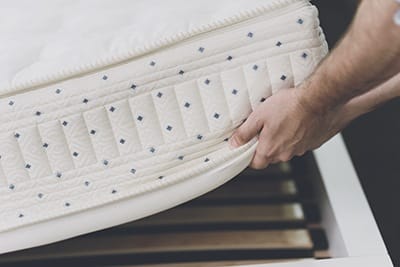 An adjustable bed — also called an adjustable base or foundation — is a flat and supportive type of bed that has hinges and allows one to change positions. Think of a hospital-grade bed, where the head and feet raise and lower (among other options), but made for use at home.
An adjustable bed — also called an adjustable base or foundation — is a flat and supportive type of bed that has hinges and allows one to change positions. Think of a hospital-grade bed, where the head and feet raise and lower (among other options), but made for use at home.
Not all mattresses work with adjustable beds. “Make sure you pair an adjustable frame with a quality adjustable mattress because the flexing motion causes extra wear,” says The Better Sleep Council. “Mattresses and foundations not built for adjustable beds should not be used on an adjustable bed frame. Adjustable mattresses can be innerspring, foam or a combination of the two.”
RELATED: Adjustable Bases Skyrocket In Popularity Among American Mattress Shoppers
Buying a Mattress In-Store
Looking for the best place to buy a mattress? So how does one go about buying a mattress? There are two main options: buying in a store or online.
A variety of retailers offer mattresses, including:
- Big box stores
- Department stores
- Specialty stores
- Furniture stores
Regardless of their type or if they specialize in mattresses, these stores should all have competent and knowledgeable people to assist you and a variety of mattresses and models to choose from.
Prepare for a shopping trip at any of these stores with the following tips:
- Have some ideas in mind before walking in. Before heading out to shop in-store, spend a minute thinking about what you like or dislike about your mattress, sleeping position, and special needs. Take a peek online at the different brands available in the store you’re going to so you have a place to start when walking through the door.
- Lie on the mattress. Do not purchase a mattress you haven’t laid down on in the store. Wear comfortable clothing, and tell the salesperson that you need some time. Aim for five to 10 minutes on the bed in the position you typically sleep in. While it’s not a lot of time, a Consumer Reports evaluation found that “panelists who took beds home for a month-long trial rarely changed the opinion they formed after the first night.”
- Confirm the return policy and warranty details while in the store. Since there is a salesperson right there, make sure to ask if they offer a trial period or what their return policy might be. For example, is there a restocking fee? Ask how long the warranty is and what the details might be. (Check our Warranty section for information regarding what questions to ask.)
- Plan to negotiate. Some stores may be willing to negotiate the price of the mattress. Specialty chains typically have big markups and can bring the price down pretty significantly if you haggle. If you’re also considering a foundation or box spring, you can try to work that into the deal along with any potential restocking fees. It’s also worth asking if the company offers any price match guarantees (although it can be hard to comparison shop between bigger chains).
Why Comparison Shopping Between (Some) Retailers Can Be So Difficult, and Why Negotiating Is So Important
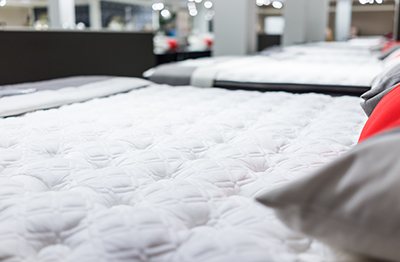 It may seem daunting at first, but in many cases, it is possible to haggle the price of a mattress. Of course, this will only work with retailers — both in-store and online — who are willing to negotiate. In many cases, specialty chain stores with a lot of inventory or showrooms tend to be willing to haggle for the price of the mattress and/or return or restocking fees associated with the purchase.
It may seem daunting at first, but in many cases, it is possible to haggle the price of a mattress. Of course, this will only work with retailers — both in-store and online — who are willing to negotiate. In many cases, specialty chain stores with a lot of inventory or showrooms tend to be willing to haggle for the price of the mattress and/or return or restocking fees associated with the purchase.
First, experts say to come prepared. Do some research ahead of time and have an idea of what’s out there at various prices.
If there is a specific model that has gone on sale before, remember the price and the date (have some proof, such as a screenshot or a flyer, if you can) and bring it in ready to discuss. It is also possible to chat with customer service representatives online to see if they are willing to share any promotions or deals. Signing up for newsletters sometimes results in discounts as well.
Some retailers will guarantee a best price or price match from another store. The tricky part here is that mattress retailers are notorious for making it hard to compare mattresses.
“Unlike products that have the same name or model number no matter where they’re sold (a Samsung Family Hub refrigerator, for example, or a Vitamix blender), mattress makers often give the same model different names depending on where it’s sold, making it almost impossible for a consumer to compare prices,” wrote Consumer Reports earlier this year. Consumer Reports also found mattress makers may slightly alter their constructions or materials from one retailer to another. “So don’t expect a salesperson to be able to guide you to a comparable model,” concluded the report.
You may have your best luck if you haggle the prices on mattresses in the back of the store, according to an article from the Huffington Post.
Buying a Mattress Online (Direct-To-Consumer)
So, how do you buy a mattress online? Many people prefer to buy mattresses on Amazon or through retailers that will send a mattress directly to their doors. This not only cuts out the hassle of driving to a store and dealing with a potentially smothering salesperson, but it often means one can skip the price markup from these stores and get a better deal on a bed.
One downside to this method of purchasing a mattress is that you won’t get to try out the bed in person before you buy it. That is why many online retailers — also called bed-in-a-box mattress brands (even though not all beds purchased online are boxed up) — offer free shipping and risk-free trial periods so you can take some time at home to decide if the bed is right for you.
Here are some best way to get the most out of an online mattress purchase:
- Have an idea of what you want. This is similar advice to shopping in-store, but it really will save time and lessen the chance of hating a new mattress and having to return it. Spend some time researching brands, reading reviews, and defining personal preferences, mattress goals, and budget in advance.
- Check out mattresses during sales periods. While many bed-in-a-box retailers won’t haggle, that doesn’t mean their products won’t go on sale every now and then. Big holidays like Black Friday (or even smaller ones like Presidents’ Day) can be good for mattress sales both online and in-store, so keep your eyes open and don’t be afraid to chat up that customer service rep to see what promotions are available.
- Get ready to unbox it. Once you’ve found the ideal brand and model and made your purchase, more likely than not your mattress will show up compressed at your doorstep. Some online retailers will offer White Glove Delivery — in which the delivery people will set it in the bedroom — but in most cases, customers are left to get the mattress on the bed by themselves. Make sure it’s okay for the mattress to be left outside your house if you won’t be home, and enlist friends or family to help you move it if need be. Follow all unboxing instructions and allow the mattress to “breathe” or ventilate with an open window or fan if needed.
- Use the trial period wisely. If the mattress comes with a trial period, make sure to spend as much time on the mattress as possible to let your body adjust to the new construction and to make sure the mattress was a sound investment. Read all the fine print so you don’t unintentionally do something to the mattress (such as staining or damaging it) that makes it impossible to return.
- Return it if necessary and try again. If a mattress doesn’t work out, contact the brand’s customer service team and arrange to have the mattress picked up. Don’t worry; they won’t put the old bed back into their inventory to re-sell — but that does make this process less environmentally friendly. Ask the retailer what they plan to do with the returned mattress; some retailers will donate them.
RELATED: Best Online Mattresses
Buying a Used Mattress
The idea of keeping a mattress out of the landfill may be a noble one, but there are a lot of reasons to avoid buying a used mattress and opting for something new instead. The biggest factor is one’s safety or the safety of the person who is going to sleep on the mattress.
The truth is that it’s very hard to assess the quality of a used mattress. Federal rules and regulations regarding mattress safety have all changed (for the better) over the last decade. Without cutting the mattress open and digging into it, it can be very difficult to know if the mattress is safe, what chemicals it was made with, and if it will provide the appropriate level of quality and support.
Sure, a free mattress on the street corner may seem tempting if one is strapped for cash. But it’s a very easy way to invite bedbugs into the home. It’s easy for these bugs to burrow deep into a mattress and pop up at night. The cost of getting rid of the bedbugs (not to mention the pain of the itchy bites) is not worth the savings on a used mattress.
RELATED: Where The Bedbugs Bite: Mapping Reports Of Bedbugs In The U.S.
Mattress Prices: Worth the Investment?
Buying a mattress is a big investment — and like most investments, you get more the more you’re willing to pay. That being said, it’s possible to find decent mattresses for relatively cheap.
Here’s an overview of what should be available in various price ranges. The prices reflect full-price offerings in a Queen size.
$250 to $500
These will be the most basic options with limited details and features. It is possible to find innerspring, foam, and maybe a few hybrid options in this range. The brand names may not be super familiar, so it’s wise to do some research beforehand. Expect fewer coils and less dense foam layers, so the durability won’t be as high as more expensive options. But it’s definitely possible to find a new bed in this price range.
If you’re shopping in this price range, check out the best affordable mattresses.
$501 to $1,000
In this price range, it is easy to find a selection of all types of mattresses, including hybrid models, adjustable air beds, and even some basic smart mattresses. They will most likely not be the most luxurious models, but they will be made with high-quality materials and come with a decent trial and warranty period.
If you’re shopping in this price range, check out the best mattresses under $1,000.
$1,001 to $2,000
In this range, one will see more premium materials become available. Gel-infused foams, natural latex, and organic options should be accessible at this price point. Top-name brands and bed-in-a-box retailers should all have several models in this range as well, which really opens one up to comparing beds in detail.
If you’re shopping in this price range, check out the best mattresses under $2,000.
$2,001 to $5,000
Mattresses in this range will come with the newest and most exclusive materials that are durable and made with quality workmanship. One should be able to find more natural options; smart beds with high-end technology are also included in this price range. There are a lot of options in terms of where to shop, from high-end retailers to the most well-known online brands and everything in between.
$5,000-plus
These are the top-of-the-line, high-end luxury mattresses. The utmost attention to detail can be found here. For $5,000 and up, one can expect superb craftsmanship and mattresses that take days to make by hand. They will feature the most natural materials sourced from all over the world. Coil count? We’re talking 4,000-plus.
If you’re looking for the best of the best, check out the best luxury mattresses.
Trial Periods & Warranties: What to Expect
Trial Periods
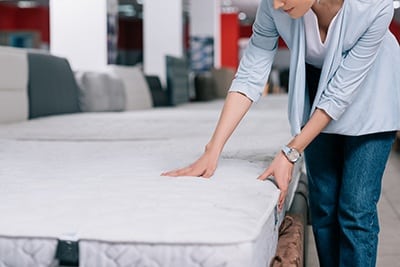 Basically, a trial period means a customer gets a certain amount of time to try your mattress out at home risk-free before deciding if they would keep it. This option has become increasingly popular. That’s especially true for bed-in-a-box and other online mattress sales, which don’t let one feel out the bed before purchasing it. Trial periods are a way to help customers confirm that a mattress is a good fit before fully investing.
Basically, a trial period means a customer gets a certain amount of time to try your mattress out at home risk-free before deciding if they would keep it. This option has become increasingly popular. That’s especially true for bed-in-a-box and other online mattress sales, which don’t let one feel out the bed before purchasing it. Trial periods are a way to help customers confirm that a mattress is a good fit before fully investing.
As noted above, while many mattress retailers will take the mattress back, they will not reuse it. This can create a wasteful situation from an environmental standpoint. Try your best to make a purchase that you think will be the best fit to avoid sending back too many used mattresses.
Warranties
Generally speaking, the mattress warranty is an important piece of information that covers customers if there is a manufacturing or product defect. The Federal Trade Commission says the law requires that warranties be available to read before buying — even when shopping by catalog or on the internet.
Always make sure the mattress has a tag attached that says “do not remove under penalty of law.” This will ensure the mattress has not been tampered with.
Here are some additional things to look out for when checking a mattress warranty:
- Length of the warranty. Mattress warranties come in a variety of lengths. Many will be stipulated in years, but one may also see some “Lifetime” or “Limited Lifetime” options. Always read the fine print to determine exactly how many years that is.
- Prorated vs. non-prorated. In some cases, a manufacturer will pay shoppers back for the full price of a mattress but only during the first number of years they own a mattress. After that, one could be responsible for a percentage of the mattress price should something come up in the warranty.
- Sagging. Sagging, particularly in a mattress made of foam, is a common warranty issue. It’s worth looking to see if a certain sagging depth is included in the warranty. This way, if the bed sags a lot and you are worried about a defect, you can measure to see if you are covered by the warranty.
Keep in mind there are a couple easy ways to void your warranty:
- Staining or damaging the mattress with any sort of fluids is a surefire way to void a warranty. The easy way to ensure this won’t happen is to put a waterproof protector on the mattress immediately after purchase.
- Your warranty will be void if you do not provide the proper support for your mattress. The warranty should indicate which type of support is needed; this will vary depending on the mattress’s construction. (See our section above on box springs, foundations, platform beds, and adjustable beds for more information.)
- In some cases, it is necessary to rotate or flip the mattress on a consistent basis so it wears evenly, and failure to do so may void the warranty.
- Removing the mattress tag may void the warranty, which is why it’s important to keep the tag on the mattress.
- If you are not the original owner or purchaser of your mattress, the warranty will not be in good standing.
- The manufacturer’s warranty does not cover the event that you just don’t like your mattress. If it doesn’t meet your standards simply based on personal preference, you will most likely not be able to get a refund (unless you’re within a risk-free trial period timeline).
Mattress Delivery
Before you grab the rope and get ready to strap that mattress onto the roof of your car, arm yourself with information about the different ways you can get your mattress to your house. Here are some of the most popular strategies:
- Ship it directly to your door. More likely than not, retailers will offer an option to have the mattress delivered to your door. Many bed-in-a-box retailers offer free shipping, and you may be able to negotiate that into the price of your mattress if picking one out in a showroom. Just make sure you figure out if you need to be home to sign for it or if they can leave it at the door (and be sure it’s safe to leave your new bed unattended).

- Upgrade to White Glove Delivery service. Some retailers offer an elevated mattress delivery experience. White Glove means one or two people will deliver the mattress and set it up in the bedroom, taking away all the unboxing materials with them. In some cases, they may even take away the old mattress. This is usually an added cost, but if the old bed is heavy or there are a lot of stairs, it could be worth it.
- Hire someone to get it home. Luckily it’s 2018, and there are services that let you hire people to help you with things such as moving a mattress. If you need someone to grab your bed and bring it home, consider options such as TaskRabbit to get some assistance.
- Bring it home yourself. There’s nothing like carting that mattress home the old-fashioned way: in the back of your car or the bed of your truck. If you don’t have a truck, try asking a friend or family member if you can borrow one in exchange for dinner or a full tank of gas. Just remember to use straps to keep the mattress firmly secured. Also, make sure to read about how to move a mattress.
If you are accepting a delivery, always inspect your mattress and/or box spring or foundation before the delivery person leaves, and refuse to take it if it is damaged. Check to make sure the mattress tag that says “all new material” is attached as well. If your bed-in-a-box arrives at your door when you’re not home, look at it as soon as possible and call customer service if you find any issues.
Also, don’t forget about mattress disposal. Make sure that the delivery service will take your old mattress when you deliver your new one.
Mattress Protectors: Can’t Forget These!
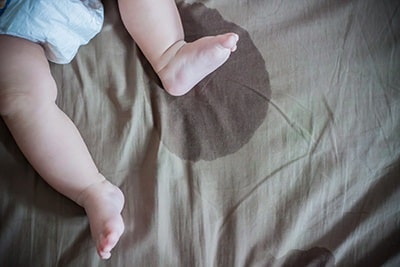 So, the mattress is home. Now, it’s time to take care of it. Mattress protectors do exactly what the name suggests — they protect your mattress. Protectors offer a range of benefits, but almost all of them work to prevent stains from fluids and liquids and prevent allergens from getting into the mattress. Here’s a closer look at the many benefits of mattress protectors:
So, the mattress is home. Now, it’s time to take care of it. Mattress protectors do exactly what the name suggests — they protect your mattress. Protectors offer a range of benefits, but almost all of them work to prevent stains from fluids and liquids and prevent allergens from getting into the mattress. Here’s a closer look at the many benefits of mattress protectors:
- Waterproofing. As noted above, many mattress warranties will be voided if the mattress is stained. Encasing the mattress in a waterproof protector will help protect it from stains and maybe save some cash in the long run.
- Combating allergens. Mattress protectors provide a barrier that prevents dust mites and other allergens (such as molds, dead skin cells, and so on) from collecting in the mattress. This helps increase the mattress’s lifespan and overall sanitation.
- Protecting against bed bugs. Some protectors will provide a barrier against the dreaded bed bug — something no one wants to deal with.
- Regulating body temperature. Some mattress protectors are made with specialized fabric and materials to promote breathability and help keep sleepers cool at night.
- Providing additional comfort. Some mattress protectors act as a mattress pad and offer quilting or fabric that adds a soft layer in between the mattress and bedding.
The two most popular styles of mattress protectors are Fitted and Encasement styles. Here’s a quick look at each of these mattress protector types:
- Fitted. Fitted mattress protectors go on the bed the way a fitted sheet does. These are very to get on and off the bed and are also affordable.
- Encasement. Encasement protectors cover and protect all six sides of the mattress. These tend to be zipped up the side. People who like encasement mattresses are usually trying to avoid allergens and/or bed bugs.
Why a Pillow Matters
Purchasing a new mattress may require investing in a new pillow as well.
Here’s why: The ideal sleeping position is one that puts the head, neck, shoulders, and spine in neural alignment, so that there’s minimal stress on any part of the body. If you’ve been sleeping with a specific pillow on an old and sagging mattress, it may feel different on the head and neck if you move to a firmer or more supportive option.
If you wake up with neck pain after sleeping on your new mattress, that’s a sign you may need to adjust the loft and firmness of your pillow to accommodate your new sleeping position.
RELATED: Best Reviewed Pillows
How to Keep a Mattress Clean and in Good Condition
Adding a mattress protector is a good start, but there are several additional tips and tricks that will help keep a mattress in good shape and increase its lifespan in the process.
Vacuum the Mattress
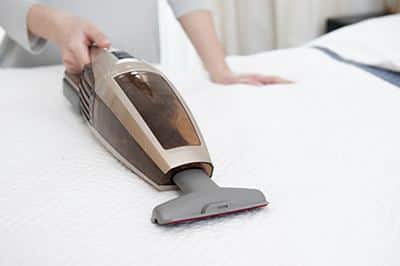 Making time to vacuum your mattress at least twice a year will help prevent a buildup of sweat, dust, and allergens, says home maintenance guru Bob Vila to TODAY. If you can remember to do it when you rotate your mattress seasonally, even better.
Making time to vacuum your mattress at least twice a year will help prevent a buildup of sweat, dust, and allergens, says home maintenance guru Bob Vila to TODAY. If you can remember to do it when you rotate your mattress seasonally, even better.
Remove all the linens from your bed before vacuuming. Vila suggests using the vacuum’s appliance (upholstery) attachment and spending a little extra time on the seams, where most buildup tends to settle.
Address and Spot-Clean Stains Immediately
Stains happen. Instead of leaving them to dry and pretending they never existed as you pull your sheets back over your mattress, you should vacuum and spot-clean them immediately to increase the longevity of your mattress.
The team at Home Revolution say to attack stains with lemon juice and salt:
Mix lemon juice and salt together to create a coarse paste. Gently rub it onto the stain, and let it sit for 30-60 minutes. Wipe it off with a clean towel, and the stain will have lightened. The bleaching powers of lemon and the moisture-removing properties of salt are perfect union [against] stains. However, if you have a dark colored or dyed mattress, do not use lemon because it will bleach and harm the color.
Another option is to combine natural liquid dish soap, baking soda, a few drops of hydrogen peroxide, and water in a spray bottle. Spray it on the stain and then blot away with a clean rag. Although this takes a little extra elbow grease, it does wonders to remove old marks.
Deodorize the Mattress
As part of the mattress cleaning process, consider using baking soda to deodorize the mattress. Here is what Consumer Reports suggests:
Deodorize the mattress by sprinkling baking soda over the entire surface. Especially if this is your first cleaning, don’t be afraid to empty an entire 1-pound box onto the mattress. For best results, leave the baking soda there for 24 hours. That means you might need to plan the project around an overnight trip — or be willing to sleep elsewhere in your home.
If you can place the mattress near a window, the sunlight will add [to] its sanitizing power.
RELATED: 11 Ways To Make Your Mattress Last Longer
Flip or Rotate the Mattress
Flipping or rotating the mattress ensures even wear and helps the mattress last as long as possible. Depending on which type of mattress you have, you may or may not need to flip it. Older and more traditional mattresses may still benefit from being flipped, while the new generation of mattresses is made with specific and customized layers that may not require flipping or rotating. Others may not require flipping but will need an occasional rotation.
To determine what is best for your mattress, check with the brand and manufacturer that makes it. They should be able to provide instructions on whether or not you should flip or rotate your mattress. You may also find the details listed under the warranty.
Generally speaking, memory foam, latex foam, hybrid, and innerspring mattresses tend to benefit from a rotation every quarter (or every three months). Also, remember to rotate the mattress 180 degrees when the seasons change.
RELATED: How Often Should You Rotate or Flip a Mattress?
The Bottom Line
There are definitely a lot of factors that go into buying a new mattress. The more you know about your own personal sleep habits and preferences, the easier it will be to navigate the world of mattress sales online or in-store.
Remember, there is no one “universal best mattress” out there that is a good fit for everyone. So take your time researching your options, and always read the fine print before signing on the dotted line. The great news is many modern mattress brands offer trial periods or generous return policies, which allow you to spend a few nights on your bed before making a long-term commitment.
We’re always here to answer any questions you may have about all things mattress- or bedding-related. If you’re feeling stuck or confused, don’t hesitate to reach out to us via our site or social media. We hope you’ve enjoyed this mattress buying guide and good luck mattress hunting!
Featured image: Iakov Filimonov/Shutterstock
Additional images:
Freeograph/Shutterstock
PRESSLAB/Shutterstock
Ivelin/Shutterstock
GUNDAM_Ai/Shutterstock
Ivelin/Shutterstock
VGstockstudio/Shutterstock
A. and I. Kruk/Shutterstock
LightField Studios/Shutterstock
Sean Locke Photography/Shutterstock
PreechaB/Shutterstock
xieyuliang/Shutterstock

